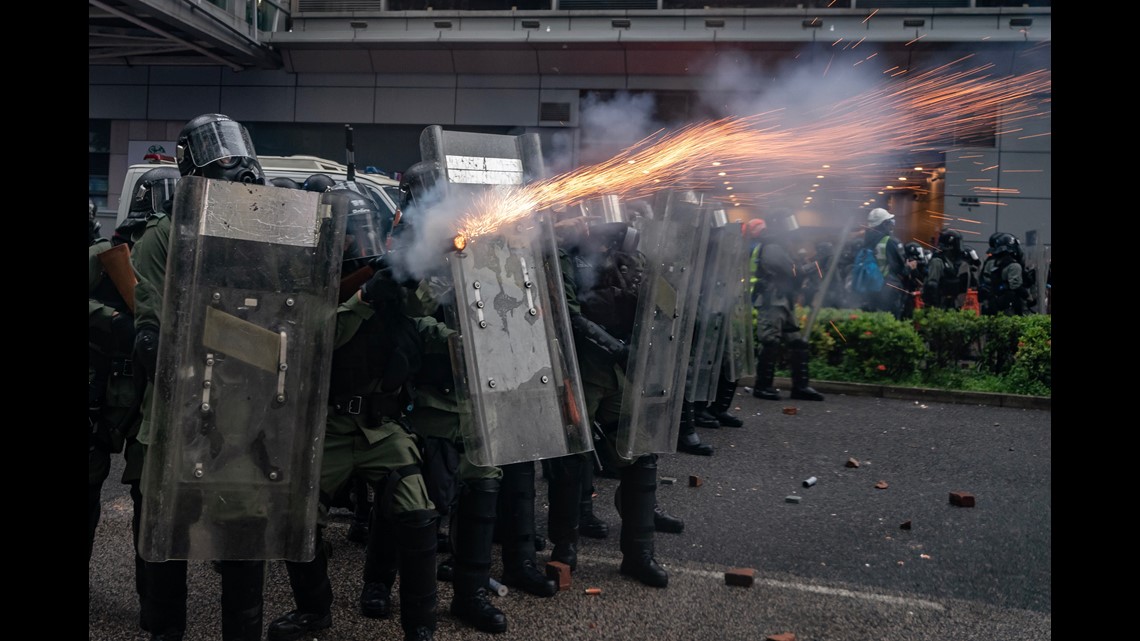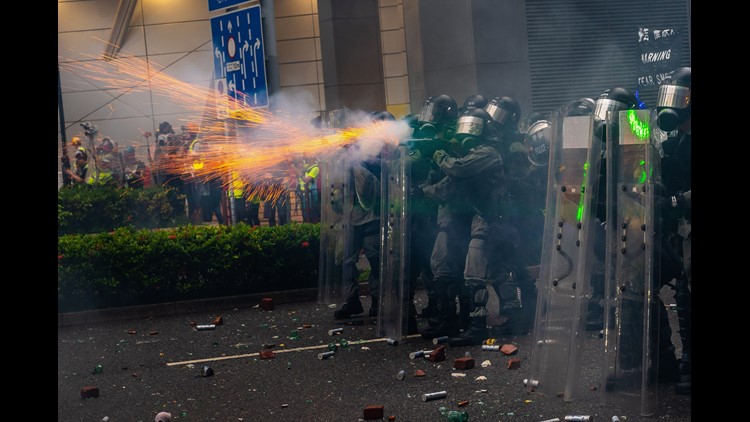

HONG KONG — Hong Kong protestors squared off against city police amid petrol bombs and clouds of tear gas on Sunday, even as the rest of the city went about its usual business in calm.
The day’s pro-democracy protests were largely peaceful, with thousands of protesters marching from Kwai Chung to Tseun Wan district, in the city’s New Territories. They showed up despite an ongoing thunderstorm, dressed in plastic ponchos and rain coats, huddled under a sea of umbrellas. According to organizers on the messaging platform Telegram, the march was intended to reiterate protesters’ core demands, as well as express opposition to alleged police brutality.
Later in the evening, a smaller group of protesters broke away from the main march and proceeded onto an extended march that had not been approved. They used traffic cones and street railings to build makeshift barricades in the street, and threw bricks and petrol bombs. Police deployed tear gas into the group but failed to disperse them, and later used a water cannon against a barricade set up by protesters.
It was the first time water cannons had been used in a protest in the past three months, although protesters themselves were not targeted, a Hong Kong police spokesperson tells CNN.
Violence had previously broken out Saturday, after thousands in the city’s east Kwun Tong district marched for the movement’s five demands, and against the government’s installation of “smart” environmental monitoring lampposts, which have sparked privacy concerns.
This 12th weekend of consecutive protests marked the end to a brief calm that had settled over the city. After tear gas was fired nearly every weekend in July, last weekend saw a peaceful march — the first time in weeks with no tear gas. The calm continued through the week, with protesters peacefully creating a human chain across the city on Friday — the 30th anniversary of the Baltic Way human chain.
Saturday was the first time in 10 days that tear gas had been fired.
However, senior police officials, who spoke on condition of anonymity, said this week that officers had been targeted and exposed online even while there was temporary peace on the streets. The police said officers’ personal data, contact information, home addresses, and more had been shared online, and accused protesters of threatening officers’ families.
They called the doxxing tactic “a kind of psychological war,” and said they had arrested 16 people on suspicion of disclosing personal data without consent and causing harm, and unauthorized access to a computer.
Many in the city are sympathetic to the Hong Kong police and government, and some police supporters held their own rally on Sunday, calling for a communication platform between the police and the public “to mend the broken relationship,” and asking the police to act “with malice or ill-will toward none,” according to a Facebook post by organizers.
This escalating violence had peaked in July, with numerous face-offs between protesters and police, and scores of injuries. The nonstop protests have taken a toll on everyone involved — on Saturday, Lam had posted a lengthy statement on Facebook appealing for peace and dialogue.
“After more than two months, everyone is tired. Can we sit down and talk about it?” she said, acknowledging that there were deeper societal problems beyond the immediate violence that needed to be addressed.
Hong Kong has been protesting now for almost three months. It all began in June, sparked by a controversial bill that would have allowed extradition to mainland China. Although the bill has since been suspended, protesters’ demands have evolved and expanded. Their demands include Lam’s resignation, the full withdrawal of the bill, and universal suffrage.
Lam has condemned violence and pledged greater communication with the public, but many feel that’s not enough, and several protesters tell CNN they will continue demonstrating until Lam responds to their demands.



